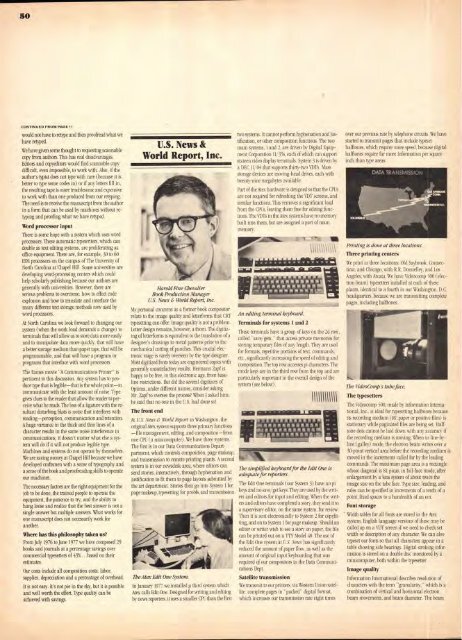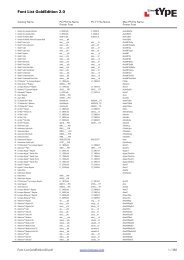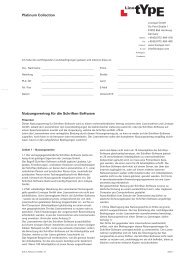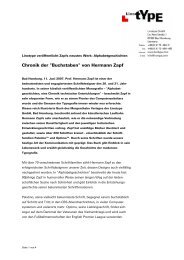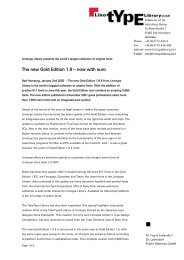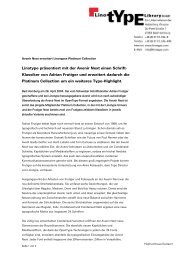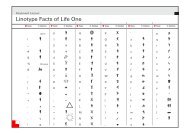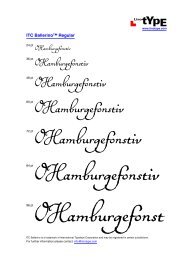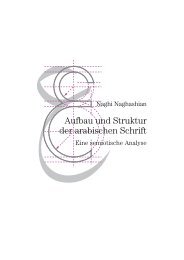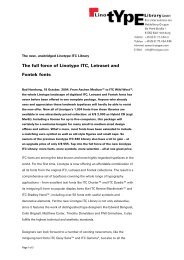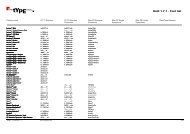AdBbCcIdFA, Ff Cig Fih hij Kk H Mm 1Nn Oo Pp Qt.! ft 41Vs ... - U&lc;
AdBbCcIdFA, Ff Cig Fih hij Kk H Mm 1Nn Oo Pp Qt.! ft 41Vs ... - U&lc;
AdBbCcIdFA, Ff Cig Fih hij Kk H Mm 1Nn Oo Pp Qt.! ft 41Vs ... - U&lc;
You also want an ePaper? Increase the reach of your titles
YUMPU automatically turns print PDFs into web optimized ePapers that Google loves.
50<br />
CONTINUED FROM PAGE 11<br />
would not have to retype and then proofread what we<br />
have retyped.<br />
We have given some thought to requesting scannable<br />
copy from authors: This has real disadvantages.<br />
Editors and copyeditors would find scannable copy<br />
difficult, even impossible, to work with. Also, if the<br />
author's typist does not type with care (because it is<br />
better to type some codes in) or if any letters fill in,<br />
the resulting tape is more troublesome and expensive<br />
to work with than one produced from our retyping.<br />
The need is to receive the manuscript from the author<br />
in a form that can be used by machines without retyping<br />
and proofing what we have retyped.<br />
Word processor input<br />
There is some hope with a system which uses word<br />
processors. These automatic typewriters, which can<br />
double as text editing systems, are proliferating as<br />
office equipment. There are, for example, 30 to 60<br />
IBM processors on the campus of The University of<br />
North Carolina at Chapel Hill. Some universities are<br />
developing word-processing centers which could<br />
help scholarly publishing because our authors are<br />
generally with universities. However, there are<br />
serious problems to overcome: how to effect code<br />
explosion and how to translate and interface the<br />
many different text storage methods now used by<br />
word processors.<br />
At North Carolina we look forward to changing our<br />
system (when the work load demands a change) to<br />
terminals that will allow us to store data more easily<br />
and to manipulate data more quickly, that will have<br />
a better storage medium than paper tape, that will be<br />
programmable, and that will have a program or<br />
programs that interface with word processors.<br />
The Eames movie "A Communications Primer" is<br />
pertinent to this discussion. Any system has to produce<br />
type that is legible—that is the whole point—to<br />
communicate with the least amount of noise. Type<br />
gives clues to the reader that allow the reader to perceive<br />
what he reads. The loss of a ligature with the resultant<br />
disturbing blots is noise that interferes with<br />
reading—perception, communication and retention.<br />
A huge variance in the thick and thin lines of a<br />
character results in the same noise interference in<br />
communications; it doesn't matter what else a system<br />
will do if it will not produce legible type.<br />
Machines and systems do not operate by themselves.<br />
We are saving money at Chapel Hill because we have<br />
developed 'cra<strong>ft</strong>smen with a sense of typography and<br />
a sense of the book and proofreading skills to operate<br />
our machines.<br />
The necessary factors are the right equipment for the<br />
job to be done, the trained people to operate the<br />
equipment, the patience to try, and the ability to<br />
hang loose and realize that the best answer is not a<br />
single answer but multiple answers. What works for<br />
one manuscript does not necessarily work for<br />
another.<br />
Where has this philosophy taken us?<br />
From July 1976 to June 1977 we have composed 29<br />
books and journals at a percentage savings over<br />
commercial typesetters of 43%...based on their<br />
estimates.<br />
Our costs include all composition costs: labor,<br />
supplies, depreciation and a percentage of overhead.<br />
It is not easy. It's not pie in the sky, but it is possible<br />
and well worth the effort. Type quality can be<br />
achieved with savings.<br />
two systems. It cannot perform hyphenation and justification,<br />
or other composition functions. The two<br />
U.S. News &<br />
main systems, 1 and 2, are driven by Digital Equipment<br />
Corporation 11/35s, each of which can support<br />
World Report, Inc.<br />
sixteen video display terminals. System 3 is driven by<br />
a DEC 11/04 that supports thirty-two VDTs. Mass<br />
storage devices are moving-head drives, each with<br />
twenty-nine megabytes available.<br />
Harold Fine Chevalier<br />
Book Production Manager<br />
U.S. News & World Report, Inc.<br />
My personal concerns as a former book compositor<br />
relate to the image quality and letterforms that CRT<br />
typesetting can offer. Image quality is not a problem.<br />
Letter design remains, however, a thorn. The digitizing<br />
of letterforms is equivalent to the translation of a<br />
designer's drawings to metal patterns prior to the<br />
mechanical cutting of punches. This crucial electronic<br />
stage is rarely overseen by the type designer.<br />
Most digitized fonts today are engineered copies with<br />
generally unsatisfactory results. Hermann Zapf is<br />
happy to be free, in this electronic age, from baseline<br />
restrictions. But did the several digitizers of<br />
Optima, under different names, consider asking<br />
Mr. Zapf to oversee the process? When basked him,<br />
he said that no one in the U.S. had done so!<br />
The front end<br />
At U.S News & World Report in Washington, the<br />
original Atex system supports three primary functions<br />
—file management, editing, and composition—from<br />
one CPU (a minicomputer). We have three systems.<br />
The first is in our Data Communications Departpartment,<br />
which controls composition, page makeup,<br />
and transmission to remote printing plants. A second<br />
system is in our newsdesk area, where editors can<br />
send stories, interactively, through hyphenation and<br />
justification to fit them to page layouts submitted by<br />
the art department. Stories then go into System 1 for<br />
page makeup, typesetting for probfs, and transmission.<br />
The Atex Edit One System.<br />
In January 1977 we installed a third system which<br />
Atex calls Edit One. Designed for writing and editing<br />
by news reporters, it uses a smaller CPU than the first<br />
Part of the Atex hardware is designed so that the CPUs<br />
are not required for refreshing the VDT screens, and<br />
similar functions. This removes a significant load<br />
from the CPUs, leaving them free for editing functions.<br />
The VDTs in the Atex systems have no memory<br />
built into them, but are assigned a part of main<br />
memory.<br />
111111111•11111111MBRENMEm10? ,.,___<br />
An editing terminal keyboard.<br />
Terminals for systems 1 and 2<br />
These terminals have a group of keys on the 2d row,<br />
called "save/gets, - that access private memories for<br />
storing temporary files of any length. They are used<br />
for formats, repetitive portions of text, commands,<br />
etc., significantly increasing the speed of editing and<br />
compoSition. The top row accesses pi characters. The<br />
mode keys are in the third row from the top and are<br />
particularly important in the overall design of the<br />
system (see below).<br />
easassaaw<br />
Rannanisiss<br />
ass<br />
111111 111\11<br />
The simplified keyboard for the Edit One is<br />
adequatefor reporters.<br />
The Edit One terminals (our System 3) have no pi<br />
keys and no save/get keys. They are used by the writers<br />
and editors for input and editing. When the writers<br />
and editors have completed a story, they send it to<br />
a supervisory editor, on the same system, for review.<br />
Then it is sent electronically to System 2 for copyfitting,<br />
and on to System 1 for page makeup. Should an<br />
editor or writer wish to see a story on paper, the file<br />
can be printed out on a TTY Model 40. The use of<br />
the Edit One system at US. News has significantly<br />
reduced the amount of paper flow, as well as the<br />
amount of original input keyboarding that was<br />
required of our compositors in the Data Communications<br />
Dept.<br />
Satellite transmission<br />
We transmit to our printers, via Western Union satellite,<br />
complete pages in "packed" digital format,<br />
which increases our transmission rate eight times<br />
over our previous rate by telephone circuits. We have<br />
started to transmit pages that include typeset<br />
hal<strong>ft</strong>ones, which require more speed, because digital<br />
hal<strong>ft</strong>ones require far more information per square<br />
inch than type areas.<br />
Printing is done at three locations.<br />
Three printing centers<br />
We print in three locations: Old Saybrook, Connecticut,<br />
and Chicago, with R.R. Donnelley, and Los<br />
Angeles, with Arcata. We have Videocomp 500 (electron<br />
beam) typesetters installed at each of these<br />
plants, identical to a fourth in our Washington, D.C.<br />
headquarters, because we are transmitting complete<br />
pages, including hal<strong>ft</strong>ones.<br />
The VideoComp's tube face.<br />
The typesetters<br />
The Videocomp 500, made by Information International,<br />
Inc., is ideal for typesetting hal<strong>ft</strong>ones because<br />
its recording medium (RC paper or positive film) is<br />
stationary while paginated files are being set. Hal<strong>ft</strong>one<br />
dots cannot be laid down with any accuracy if<br />
the recording medium is moving. When in line-byline<br />
(galley) mode, the electron beam writes over a<br />
30-point vertical area before the recording medium is<br />
moved in the increments called for by the leading<br />
commands. The maximum page area is a rectangle<br />
whose diagonal is 81 picas, in full-face mode, a<strong>ft</strong>er<br />
enlargement by a lens system of about twice the<br />
image size on the tube face. Type size, leading, and<br />
rules can be specified in increments of a tenth of a<br />
point, fixed spaces to a hundredth of an em.<br />
Font storage<br />
Width tables for all fonts are stored in the Atex<br />
system, English language versions of these may be<br />
called up on a VDT screen if we need to check set<br />
width or description of any character. We can also<br />
typeset our fonts so that all characters appear in a<br />
table showing side bearings. Digital stroking information<br />
is stored on a double disc monitored by a<br />
minicomputer, both within the typesetter.<br />
Image quality<br />
Information International describes resolution of<br />
characters with the term "granularity," which is a<br />
combination of vertical and horizontal electron<br />
beam movements, and beam diameter. The beam


